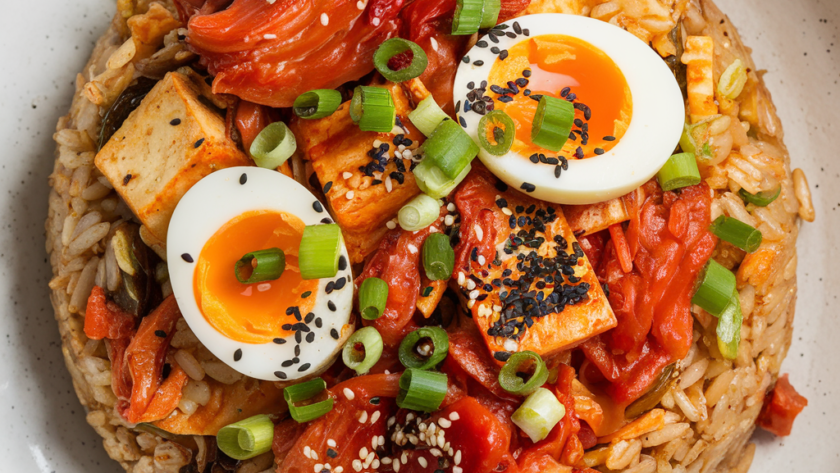Craving a quick meal teeming with taste? Look no further than vegan kimchi fried rice. This Korean-inspired dish is an explosion of spicy and tangy flavors thanks to kimchi, combined with hearty fried rice.
It’s a comforting meal, ready in a flash, perfect for lunch or dinner. Easily customizable, it caters to any palate—ideal for those busy days where flavor shouldn’t be compromised.
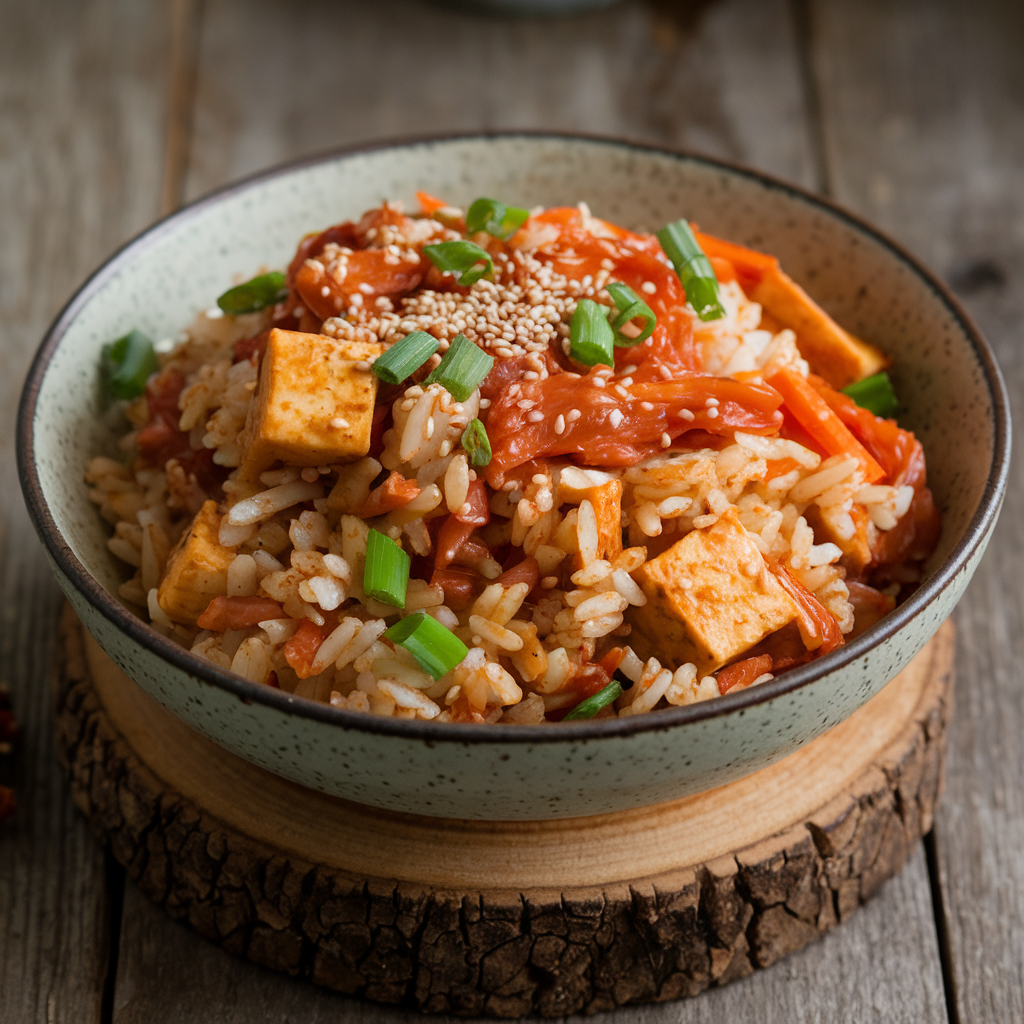
Discovering Kimchi Fried Rice
Imagine a dish exploding with flavor and simplicity: that’s vegan kimchi fried rice. This Korean comfort food, known as “kimchi bokkeumbap,” blends the robust taste of kimchi with the satisfying bulk of stir-fried rice. Such a delightful fusion makes it both a savory and fulfilling experience.
The magic lies in its ability to transform humble leftovers into a feast. Typically, you’ll find day-old rice, crunchy veggies, and the fermented zing of kimchi coming together. The result? A dish that’s as pleasing to the palate as it is easy to throw together for a quick meal.
With options for adding various vegetables and proteins, every plate of kimchi fried rice can be as unique as your culinary imagination. Whether you stick with the basics or venture into creative add-ins, the dish is always a winner.

Why Opt for a Kimchi Fried Rice Vegan Version?
Making this dish vegan is a win for both flavor and ethics. Using vegan kimchi and plant-based ingredients, you retain the spicy, tangy delight while aligning with a cruelty-free lifestyle. The result? A nutrient-packed meal that satisfies without compromise.
Traditional recipes may include non-vegan elements like eggs or fish sauce. However, substitutes like tofu and soy sauce offer the same depth, minus the animal products. This keeps the dish not just delicious, but inclusive for all dietary preferences.
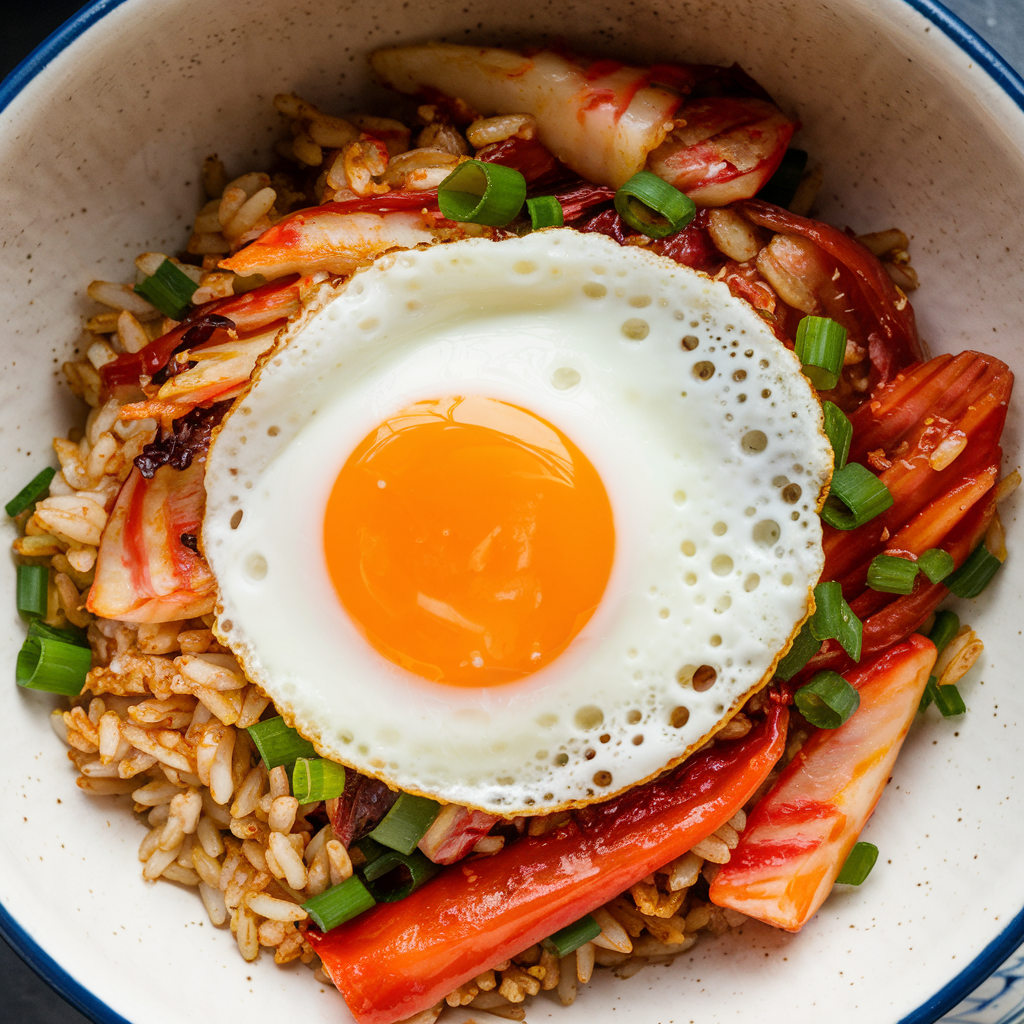
Gathering the Essential Ingredients
When crafting this culinary masterpiece, a crucial component is the right vegan kimchi. Check that your choice is free from fish sauce or other animal-derived elements. It’s the heartbeat of the dish, bringing that famous fermented flavor.
The other elements weave together to complete the tapestry. Day-old cooked rice is preferred, alongside vibrant veggies like carrots, green onions, and bell peppers. This combination promises a colorful feast both visually and on the palate.
Soy sauce and sesame oil join forces to enhance the umami profile. For those seeking heat, adding gochujang, a fiery Korean chili paste, brings an extra sizzle to each bite. Adjust seasoning with salt and pepper to your liking for a perfect balance.
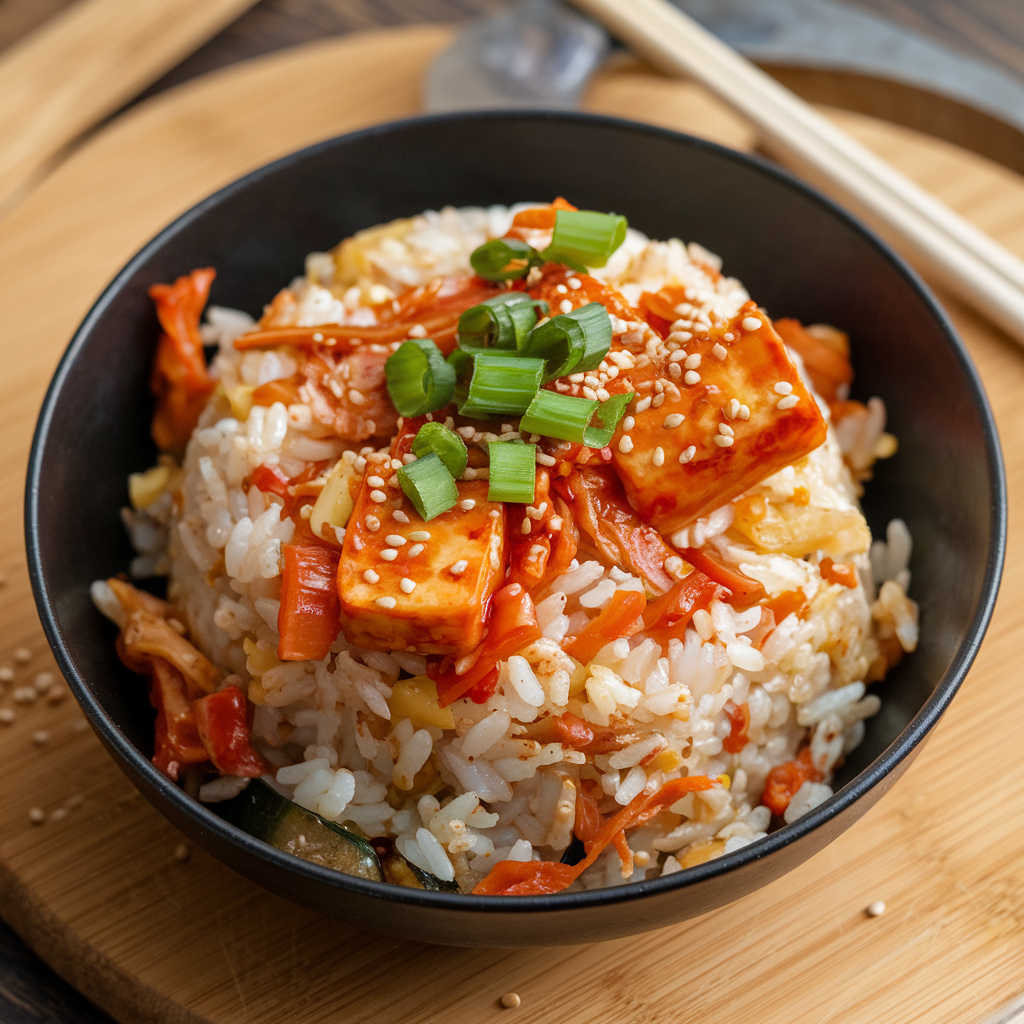
Tools of the Trade
A well-equipped kitchen ensures smooth sailing as you prepare this dish. A wok or large pan offers ample space for even cooking, ensuring those grains of rice get perfectly crisped.
Don’t overlook the small tools: as vegetables demand precise cuts, a sharp knife and sturdy cutting board are indispensable. A spatula helps in maintaining the dance of ingredients within the sizzling pan.
Preparing these tools beforehand streamlines your cooking adventure, paving the way for a successful dish. An organized space makes for a stress-free meal prep.
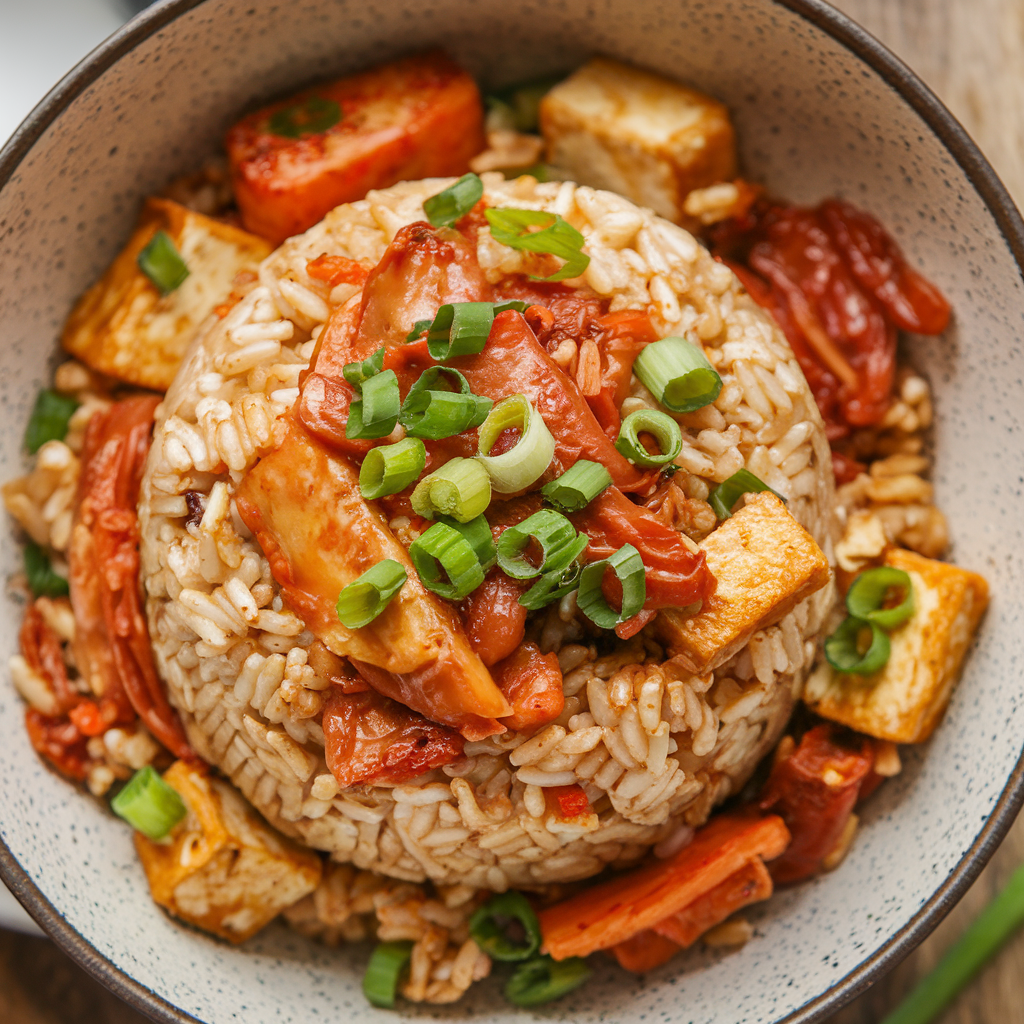
Step-by-Step Flavor Unleashing
To embark on this culinary journey, preparation starts before the heat hits the pan. Ideally, rice that’s a day old fits best; it brings better texture, less sticky than when freshly made. If new, spread it thin and let it cool.
Start by chopping your veggies—carrots diced, bell peppers cubed. Each piece should be bite-sized for uniformity in cooking. This step ensures every forkful carries the intended mix of flavors.
Heat sesame oil in your wok at medium. Sauté the veggies first until they’re just tender. Then, introduce your prepared kimchi to the mix. Stirring allows its robust taste to permeate your dish.

Perfecting the Art of Fried Rice
Introduce the rice to the wok, raising the heat slightly. Coat each grain with the savory kimchi mix, ensuring an even distribution of flavors.
Season with soy sauce and gochujang if craving heat. Stir-fry until components meld seamlessly. Aim for slight crispiness in the rice by increasing heat towards the end, rewarding you with a delightful texture difference.
Perfecting this dish may take some practice, but each attempt brings new layers of understanding the flavors. Don’t shy away from tasting and tweaking as you go—cooking is an art, not a strict science.
Vegetable and Protein Variations
Your kimchi fried rice need not be identical each time. Feel free to introduce new vegetables such as zucchini or mushrooms. Each adds a different characteristic to the blend.
For protein seekers, options like tofu or tempeh add a chewy contrast. Ensure these additions harmonize with the dish’s existing flavors. Season them well before mixing in.
By varying ingredients, the dish transforms each time, reflecting personal taste. It becomes not only a meal but a personal culinary expression.
Balancing Spice and Flavor
Heat levels can transform your dish, so adjust the gochujang to your preference. Those wary of spice might scale back or omit it, while fans of fiery flavor can dial it up for intensity.
Soy sauce is your friend in balancing salt; opt for low-sodium variants if needed. Additional herbs like green onions can decorate and enhance the final taste—don’t hesitate to experiment.
Serving this creation is a sensory delight. Top it with sesame seeds and more onions for crunch, then drizzle with sesame oil. Pair with cucumber salad or soup if desired for a full meal.
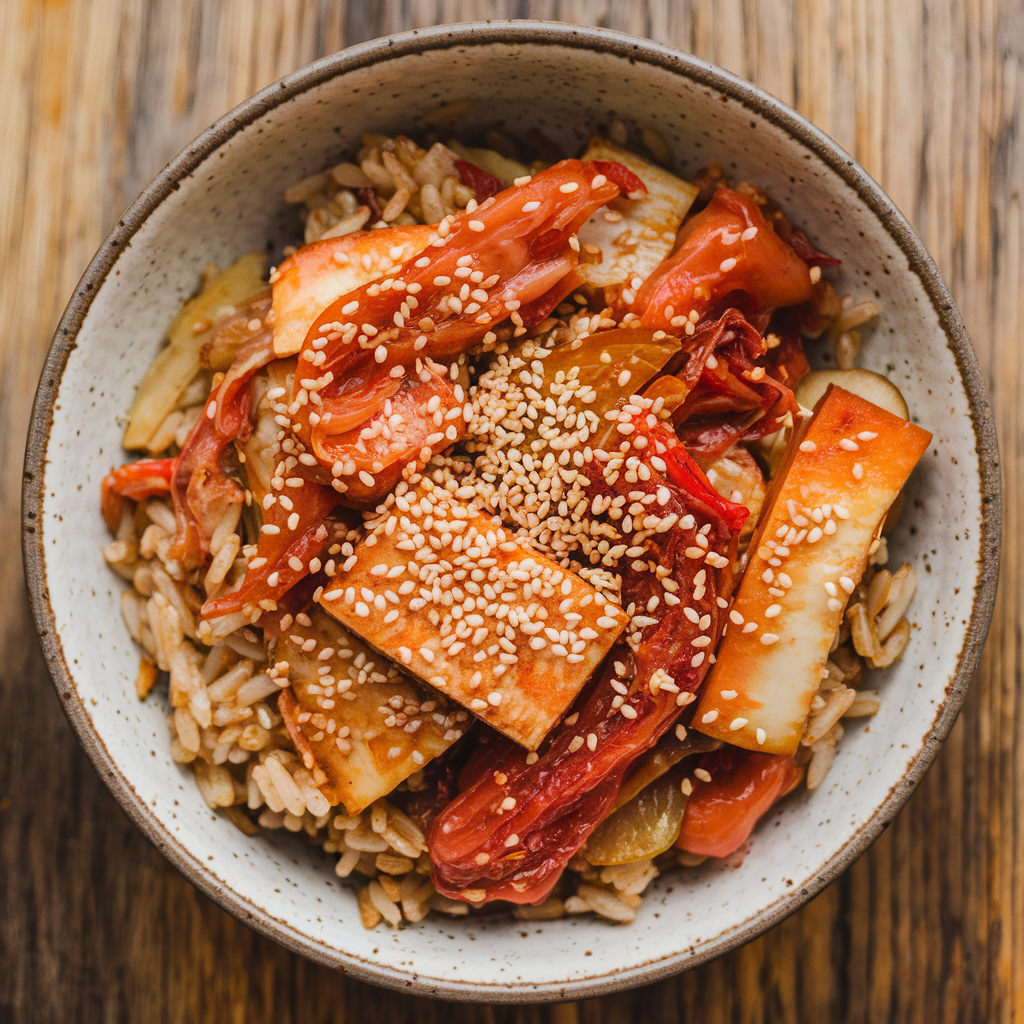
Preservation and Reheating
Store leftover rice in a sealed container for up to three days, maintaining its flavor and texture. This convenience makes it a meal-prep favorite.
Reheating doesn’t have to sacrifice quality. Add a splash of oil or water when warming to preserve moisture. Stir-fry gently over medium heat until hot.
Keep in mind that flavors intensify as the dish rests, creating a slightly different but equally enjoyable experience on repeat servings.
Vegan kimchi fried rice is a versatile, flavorful delight perfect for any occasion. With a few simple ingredients and optional add-ins, it’s a dish that nourishes and satisfies.
